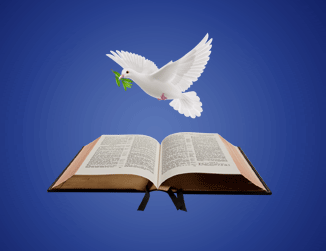Gospel of The Mystery
...and to make all men see what is the Dispensation of the Mystery which for ages hath been hid in God who created all things. - Eph. 3:9
Study to shew thyself approved unto God, a workman that needeth not to be ashamed, rightly dividing the word of truth. - 2 Tim. 2:15
Faith... Love... Hope...
By Michael Paz
Paul, an apostle of Jesus Christ by the will of God, and Timothy our brother. To the saints and faithful brethren in Christ which are at Colossae: Grace be unto you, and peace from God our Father and the Lord Jesus Christ.
"We give thanks to God... since we have heard of your FAITH... and LOVE... for the HOPE which is laid up for you in heaven. Whereof ye heard before in the word of the truth of the gospel" (Col. 1:1-5).
Such is the occurrence of the three graces of faith, love, and hope right at the very beginning of the epistle to the Colossians. These three graces also appear at the beginning of 1 Timothy but in a rearranged order:
"Paul, an apostle of Jesus Christ by the commandment of God our Saviour, and Lord Jesus Christ, which is our HOPE... Unto Timothy, my own son in the FAITH... Now the end of the commandment is CHARITY... and FAITH unfeigned." (1 Tim. 1:1-5)
The words LOVE in Colossians 1:1-5 and CHARITY in 1 Timothy 1:1-5 are the same word in the original language. The one spoken of in Colossians is a love as a result of having been justified. The other, in 1 Timothy, is love that is perfected.
The word FAITH in 1 Timothy deserves a little more attention. It occurs three times: the first, as a beginning principle (1:2), the second as a means of instruction and blessing (1:4), and last but not least as a goal (1:5).
From these, we may gather that 1 Timothy is a development (1 Tim. 4:15) of the doctrine expounded in Colossians and may actually be the Colossian letter put into practice.
This is however a study of Colossians so it is enough that we point out the links with 1 Timothy:
First, there is the companionship of Paul and Timothy. This companionship has to do with Paul being a "preacher to the Gentiles" (Col. 1:1, 27, 28 and 1 Tim. 1:1, 2; 2:7; 3:16). Also in Col. 1:27 and 1 Tim, 3:16, there is the hope of "glory".
The beginnings of both Colossians and 1 Timothy provide a spiritual link between the two letters while the three graces of FAITH, LOVE and HOPE are not unique to these two epistles, the emphasis is not on FAITH as it is in 1 Thess. 1:3-5 or CHARITY as it is in 1 Cor. 13:13. The emphasis in Colossians and 1 Timothy is on HOPE.
What is this hope? This is answered directly by 1 Timothy 1:1: It is our "Lord Jesus Christ, our hope". This is the overall context of 1 Timothy (1:1; 2:3, 4; 4:10). This is what is meant by the expression "lay hold on eternal life" (6:12, 19). Is this about the second coming of Christ then?
My answer to that is "no". The second coming of Christ is the hope of Israel (Romans 9:4,5). It is to Israel that "as concerning the flesh Christ came." (Rom. 9:5; 15: 8), and that was the burden of the book of Acts (Acts 3:19, 20).
1 Timothy 1:1 is Jesus Christ being the hope of the Gentiles (1 Tim. 3:16, cf. Col. 1:27). This brings us to a consideration of the meaning of Colossians 1:5. The hope, which is our Lord Jesus Christ is said to be laid up. A better rendering is "reserved". He is said to be "reserved" for Gentiles "in heaven". This means that the second coming of Christ cannot occur for as long as the hope of Colossians 1:5 is not realized. This is expressed in other words of the same meaning (3:1).
